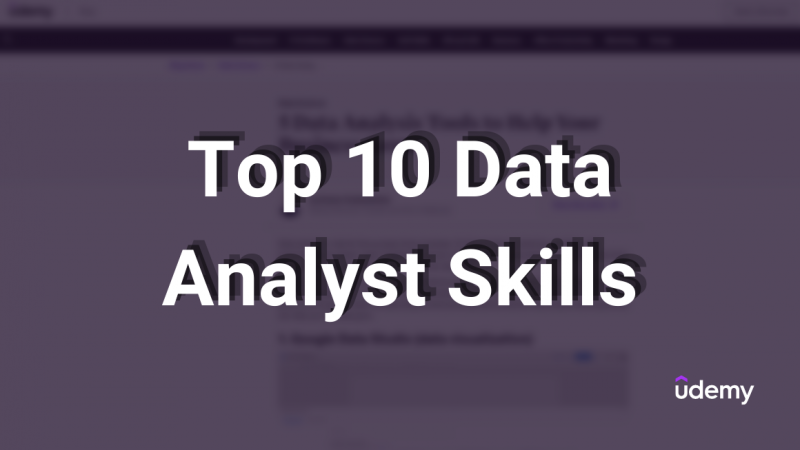The role of a data analyst is to collect and analyze data sets to assess, predict, and improve a business. Data analyst skills are derived from many disciplines including mathematics, statistics, and computer programming.
To be successful in the field of data analytics and land a great data analyst role, a combination of technical skills and business acumen will be necessary. As an analyst, you will be working with data in addition to business personnel, which means you will need a well-rounded skill set. If you are interested in becoming a data analyst, this article will explore a handful of essential skills you will need to stand out and be successful.
The data science and data analytics dictionary
On your way to entering the data analytics field, you will encounter a lot of terms, which look similar and interchangeable but unfortunately have completely different meanings. Before we get any further, let us make sure those terms are clear and the relationships between them are known:
- Big data. The field of big data deals with ways to analyze, extract information from, or otherwise deal with data sets that are too large or complex for traditional data-processing applications. To illustrate just how “big” big data is, Domo estimates that in 2020, every person will accumulate 1.7 megabytes every second.
- Data science. In 2012, the Harvard Business Review deemed the job of a data scientist as “The Sexiest Job of the 21st Century,” which has been going from strength to strength even until today. In essence, data science is an interdisciplinary field that combines math and statistics, specialized programming, advanced analytics, and storytelling to uncover and explain the business insights buried in data. Often, data science uses complex machine learning algorithms to build predictive models.
- Business intelligence (BI). Data preparation, data mining, data management, and data visualization are all included under the umbrella term, business intelligence.
- Data mining. This is the process of finding patterns, correlations, and anomalies within a large set of data to discover business intelligence that can drive business growth.
- Data warehouse. Also known as an enterprise data warehouse, this is a type of data management system that acts as a central repository for and supports the development of business intelligence activities, especially data analytics.
- Artificial intelligence (AI). In contrast to the natural intelligence displayed by humans, artificial intelligence is demonstrated by machines.
- Machine learning (ML). The concept of machine learning is, in fact, a branch of artificial intelligence and computer science that uses data and algorithms to simulate the way humans learn, gradually increasing its accuracy.

Dynamic Dashboards and Data Analysis with Data Studio – 2021
Learn how to build powerful data visualizations and unlock insights with ease in Google Data Studio
Key data analyst skills
1. Problem-solving and critical thinking
As a data analyst, you are going to be solving problems and interpreting answers every day. The role of an analyst is to present a question or concern and use data to infer a solution and produce actionable insights. If you are determining the functionality of data or the significance of a trend, you will need problem-solving and critical thinking skills.
2. Communication
Insightful discoveries are useless if you can’t communicate them to the rest of your team clearly. Therefore, in addition to analytical skills, data analysts must possess effective communication skills to do this.
As an analyst, you will be collaborating with a team or meeting with stakeholders often. Your ability to communicate successfully will be tested and will need to be strong. You will have to explain a complex idea or describe a detailed analysis, and if you are not able to do so, your findings will be pointless.
3. Data cleaning and preparation
An important step in the data analysis process is the cleaning and preparation of the data that you are working with. This means taking raw data from one or more sources and reformatting, combining, and correcting it to create an accessible data set that offers insight for an analysis. If the data is not properly prepared, the analysis will be affected, and the results will be biased.
The responsibilities you will have while cleaning and preparing data may include:
- Standardizing data formats
- Identifying missing or inconsistent data
- Merging, splitting, or joining input sets
- Removing outliers
The role data preparation takes in the analytics process is crucial to ensuring the quality and accuracy of your work. Homing in on this key skill is vital for a successful career in the industry.

4. Statistical knowledge
While you don’t have to have an expert level of statistical knowledge, a fundamental understanding is key to interpreting the data you are working with.
The level at which you will need to know statistical analysis will vary by role and data type. However, every professional in the field of data science should have a base level of statistical knowledge. A few concepts that will provide an advantage when analyzing data include:
- Regression analysis
- Standard deviation
- Coefficient of variation
- Correlation coefficient
- Covariance
- Inferential statistics
- Dummy variables
Having insight into how statistics are and will be affected by the data you’re analyzing will help you as an analyst. This is not necessarily about becoming a data scientist, but rather about ramping up your technical skills and understanding. There are courses available that can teach you fundamental statistical concepts and theories.
5. Microsoft Excel
Most office workers are familiar with Excel, but data analysts need to be expertly skilled and able to use the program’s more complex features.
Excel’s analytical and modeling tools will guide you in organizing, cleaning, and manipulating data sets. The program also offers tools to help identify and visualize patterns and trends. Excel has been a cornerstone of the industry for years and is an essential skill you will have to use every day.
6. SQL
Structured query language (SQL) is used to communicate with a set of structured data, allowing for data or subsets of it to be extracted or combined while providing a means to update, organize, and modify data structures. This is normally executed through a SQL query in a relational database such as Google BigQuery or Microsoft SQL Server.
Most data analysts will have to use SQL to retrieve data for their analysis, so it is an essential tool to have under your belt. Many data analyst positions will require having SQL knowledge and may even have a technical screening to demonstrate your skill using this language.
SQL is one of the simpler languages to understand and is an excellent place to begin when learning how to use programming languages.

7. Statistical programming
While knowing SQL is key for this industry, you will also need to learn statistical programming languages. Python and R are powerful programming languages that are popular in the industry. They are both open source and free to use, functioning as a means to complete advanced analysis and manipulation of large data sets.
In addition to Excel and SQL, understanding Python and R will drastically increase your efficiency and accuracy as a data analyst. While knowing both is ideal, learning at least one of these two statistical languages will help you become a well-rounded analyst.
R was designed specifically for use in data science and analysis. Python, however, was created as a multi-purpose tool and happens to have some application to data analytics. Choosing which statistical programming language you learn will fall under personal preference depending on your interests and field of work.
8. Python
Python is a general-purpose programming language that recently began adding libraries for data analysis and machine learning. Over time, Python has become the preferred tool for data analysts due to its ease of use and versatility. Compared to R, Python is much easier to learn and has a simple syntax that makes collaboration more convenient. Python is often a mandatory programming language in most computer science degrees or certificates.
9. R
R is a programming language that was created specifically for data analysis and is preferred by some analytics for this reason. The R language has packages that offer useful tools for preparation, manipulation, data visualization, and predictive analytics.
10. Data visualization and visual storytelling
As a data analyst, being able to access and analyze data is only part of the work that needs to be done. Once you have finished the analysis and are ready to share your results, your responsibility is now to determine how the data should be presented. If you cannot create an impactful and comprehensive visual from your data, you will not be able to communicate your findings effectively.
Moreover, even though the right answer or interpretation might be obvious to you, your audience could still end up confused. Being able to identify the trends and patterns of your data and deciding how to illustrate them is a crucial aspect of data analysis. Therefore, good presentation skills are mandatory for all data professionals.
A tool like Google Data Studio can be a great starting point for learning how to visualize and communicate key business findings to those who do not understand the complex data.
Job seeking tips for a data analyst role
Data analysts are growing in demand every year at an above-average rate. As we already established, a data analyst position requires a wide range of technical skills and domain knowledge. However, the benefits of becoming a data analyst are great, to name a few:
- Ability to work with large brands and their unique data
- Great entry-level salaries and opportunities for growth and specialization
- Freedom to work from anywhere, as the nature of the job is remote-friendly
If you have a knack for critical thinking and enjoy working with data and statistics, becoming a data analyst may just be the perfect fit. If you are interested in looking or applying for a data analyst job, check out data analyst resume examples for inspiration and as a point of reference for your own portfolio.
What are some common data analyst responsibilities?
In a data analyst job description, you are likely to find quite a few of the technical skills that we described earlier, but you should also look for the data analytics specialization and client industry.
For example, it might be a data analyst job that focuses on marketing and advertising analytics, in which case you would be using Facebook Ads, Google Search, DoubleClick, and StackAdapt as data sources. Plus, data manipulation and visualization would probably be key responsibilities.
However, another role might require a stronger data science background, where the analyst would have to build a model from first-party/CRM data.
Indeed, the data analytics world is vast, and asking about the specific tasks and client industry during your interview is highly recommended. This will shed light on the specific data analytics skills that you might need to be successful in the job.
What are some job title examples in the data analytics field?
The data analytics field is very broad. Not only can you be involved in a wide area of industries, but there are also many applicable job titles:
- Data scientist
- Data engineer
- Business analyst/business analytics
- Health data analyst
- Analytical lead
If you have any questions, feel free to reach out on LinkedIn or subscribe to the datastudio newsletter for more updates. In the meantime, happy learning!
